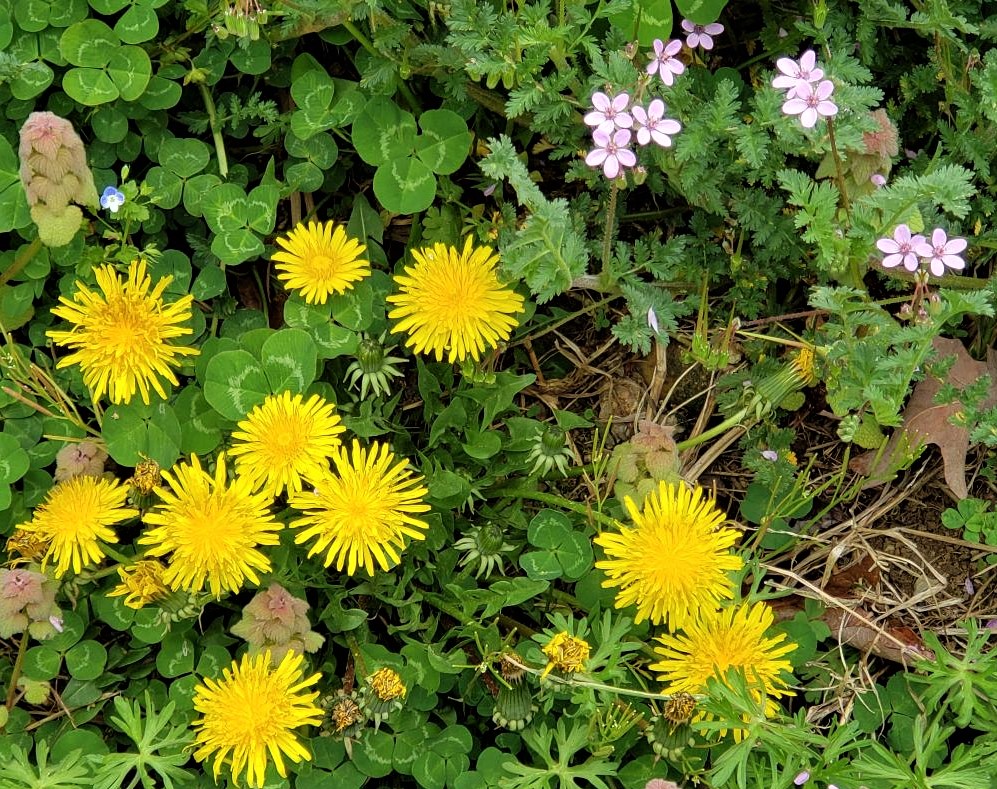
It’s dandelion time y’all and I’m excited! At first this week, I only seen a dozen dandelions, but before week’s end, I seen hundreds!
I just learned about the wonderful benefits of this “weed” a couple years ago and started eating it myself. Now I like sharing this with you!
For most people the robust yellow dandelion is just a pesty ‘weed’ which you spend lots of money on weed killer or time in pulling it up by its roots.
While, for others, like myself, we are learning what many of our ancestors had knowledge of; its entire plant has medicinal uses for mankind’s well-being.
However, the ‘old’ recipes for eating dandelion flowers and greens are again, blooming beautifully in kitchens.
The internet has multiple authors, writers and health institutions that praise the benefits of this beautiful yellow flower and its leaves. Many people are familiar with the making of dandelion wine and medicinal teas or the grinding of the roots for a coffee-like drink or jellies.
An old-time favorite is to fry the flowers to make dandelion fritters or fry them turned upside down in pancake batter, topped with a little honey for a delicious-sweet dessert.
The dandelion is an herbaceous perennial that belongs to the Asteraceae family of plants, along with daises and sunflowers. Few know, but native to Europe, dandelion seeds were brought to America by American colonists, where they were initially planted for culinary and therapeutic use.
However, there are plants that look similar to the dandelion, such as cat’s ear and false dandelion.
The true dandelion is known for its bright yellow blossoms, smooth deeply toothed leaves that point back towards the center of the plant, hollow stems and only produces one flower.
It is suggested to allow some dandelions to grow in gardens as they are an “easily available source of food” for pollinators, including bees, butterflies, beetles, and birds.
Also, never pick dandelions where one may have sprayed.
Dandelion has many health benefits, is low in calories and packed with vitamins, whether consumed raw or cooked. Every part is edible – roots, stems, leaves and flowers.
Multiple websites and major studies agree that dandelions have potential benefits for many organs and may help keep one healthy and disease-free, “providing natural, biologically active compounds, including some called flavonoids and terpenoids.”
Facts about the Dandelion:
- Contain natural antioxidants – compounds that help your body rid itself of free radicals, which are “unstable molecules made in your body that can damage cell membranes and DNA”, potentially speeding aging and raising your risk of cancer and other diseases
- “Life Sciences” found that cancerous cells cultured with dandelion extract grew more slowly and eventually died, compared to cells grown without the extract
- Reduces the risk for cancer — A study published in the journal “Oncotarget” – aqueous dandelion root extract may be a safe and effective alternative to chemotherapies, as “it efficiently and selectively triggers programmed cell death pathways.”
- Helps growth and strength of bones – rich in calcium and Vitamin K
- Assists liver functioning, having antioxidants like vitamin C and luteolin – protecting it from aging and helps treat hemorrhaging in the liver
- Aids in maintaining proper flow of bile, while stimulating the liver and promoting digestion which can reduce chances of constipation and reduces inflammation to help with gallbladder problems and blockages
- A diuretic that helps the kidneys clear out waste, salt, and excess water by increasing urine production. (Dandelion also replaces potassium lost in the process.)
- Inhibits inflammation – sesquiterpene lactones and other phenolic substances in dandelion contributes to its anti-inflammatory properties. (By fighting inflammation, dandelion may help reduce the risk for inflammation-related diseases such as heart disease, arthritis, diabetes and Alzheimer’s.)
- Used as sweeteners – low in calories
- Helps detoxify the body
- Leaf and flower extract may help reduce the risk for skin photoaging by protecting against UVB damage and suppressing the production of reactive oxygen species
- Good for feminine health, helps to balance hormones
- Rich source of beta-carotene which converts into vitamin A, fiber, iron, magnesium, zinc, phosphorus, B complex vitamins, trace minerals, organic sodium and vitamin D
- Contains more protein than spinach
- Treats anemia, scurvy, skin problems, blood disorders and depression
- Helps lower blood pressure levels and reduce the risk for cardiovascular diseases with its hypolipidemic property.
- Helps regulate blood sugar and insulin levels, through its ability to control lipid levels
- Lowers and controls cholesterol levels while improving cholesterol ratios by raising HDL may help improve levels of high-density lipoprotein (good cholesterol) while reducing serum total cholesterol, triglycerides and low-density lipoprotein (bad cholesterol)
- Boosts immune function and fights off microbes and fungi optimal immune health with its antibacterial, antiviral, antifungal, antioxidant and anti-inflammatory properties
Dandelion is generally considered safe in food and medicinal levels however, some people may have allergic reactions, therefore study before consuming.
There are many recipes you can google to eat of the dandelion bloom or its leaves, however one of my favorites is just frying them in pancake batter or dehydrate them for all year use.
Many use the stems as stir-fry, or make pesto, jelly, honey, or fried greens, or just toss the fresh blooms and leaves into a salad, while others look forward to their annual dandelion wine making.
So, who knew God was giving us a yard full of food right at our fingertips to create a wonderful salad or meal. Happy dande-eating!
-Pam Dudding


